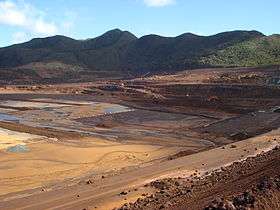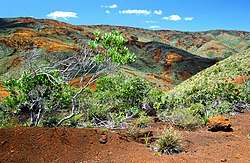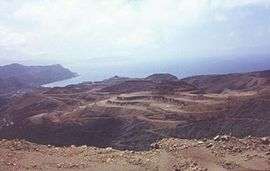Nickel mining in New Caledonia
Nickel mining in New Caledonia is a major sector of the New Caledonian economy. The islands contain about 7,100,000 tonnes of nickel which is about 10% of the world's nickel reserves.[1] With the annual production of about 107,000 tonnes in 2009, New Caledonia was the world's fifth largest producer after Russia (266,000), Indonesia (189,000), Canada (181,000) and Australia (167,000).[2] Nickel production in New Caledonia accounts for 7–10% the country's GDP and is responsible for as much as 80% towards foreign earnings.[3] With the exclusion of tourism, nickel ore and derived metallurgical products represent about 97% of the total value of exports.[4]
 A creek in southern New Caledonia. Red colours reveal the richness of the ground in nickel and iron oxides | |
| Location | |
|---|---|
| Location | subregion of Melanesia in the southwest Pacific. |
| Overseas territory of France | |
| Country | Melanesia |
| Production | |
| Products | Nickel |
| Production | 107,000 tonnes in 2009 |
| History | |
| Opened | 1864 |
History
New Caledonia has the longest history of mining in the Pacific islands. Nickel was found in New Caledonia in 1864 by the engineer Jules Garnier. It was distributed in the ore layers which cover about one third of the area of the main island of New Caledonia. The nickel concentration was inhomogeneous and also varied with the depth. Whereas its usual concentration was 2–5 percent, it could reach 10–15 percent in scattered deposits of green garnierite. Those areas were developed first using primitive manual extraction methods and were gradually depleted, resulting in the present average concentration of about 2.6 percent. This nickel is located at the depth of about 30 metres (98 ft). Shallower layers of 10–20 metres (33–66 ft) also contain nickel, but at half of the concentration. They remain unexploited and constitute most of the nickel reserves of New Caledonia.[4]
Wide-scale mining started in 1875 in Houaïlou and Canala communes. Early mining was done by hand and then gradually became mechanised. By beginning of the 20th century two large mines at Bourai and Thio were established.[5] In the initial years, after nickel was discovered mining was done in about 330 mines. However, in 1981 there were only 30 functional mines as against 130 in the early 1970s. [6] Because of the remote location of the islands, about half of the ore was smelted locally, despite the underdeveloped industrial infrastructure of New Caledonia. Another half was exported, mainly to Japan. The first nickel smelter was built in 1879 with two other added in 1910 and 1913. The smelted product contained about 70–80% nickel and was sent for refining to France. Because of low nickel content in the ore, local smelting resulted in vast amount of displaced rocks near the smelters that changed the local landscape.[4]
In the 1930s, the white 'Caldoches' and companies like the Société le Nickel dominated the economies of the colony. The native Melanesians were confined to reservations which made up only 10 per cent of New Caledonia's land area.[7] The main source of mine labor came from Asian migrants recruited by France. The arrival of these migrants from India, Japan, China, Java, and Vietnam both increased and changed the demographics of New Caledonia's population. By the 1920s, Asians outnumbered the French.
The production of ore was nearly constant between 1875 and 1948, but then increased about 70 times reaching a peak of about 8 million tonnes in 1971, at which time New Caledonia was the second largest nickel producer in the world. In the second half of the 1960s, the nickel industry experienced rapidly increasing demand linked to the Vietnam War.[8] New Caledonia's exports had quadrupled over the past decade. This rise followed by a decline, to about 4 million tonnes of ore in 1981, due to cyclones, reducing demand for the metal and increasing role of other world producers, such as Indonesia, Philippines and Australia. Correspondingly, the mined area decreased from 21,500–8,700 hectares (53,000–21,000 acres) and the number of people employed in the industry from about 6,200 to about 3,600. Nearly half of them worked at the mines and another half at the major Doniambo processing plant near Noumea.[4]
Mines
Strip mining is the most common technique adopted for nickel mining and statistics show that stripping of 500 million tonnes of overburden had to be removed to extract nickel ore, which amounted to clearing an area of 20 hectares (49 acres) per million tonne (five million tonnes of ore per year generate 25 million tonnes of tailings).[5]
The local nickel industry is dominated by the French company Eramet which has a 60% interest in its nickel mining subsidiary, SLN (Societe Le Nickel) in New Caledonia.[3] Other firms such as Falconbridge Ltd., Inco, Argosy Minerals and QNI however are still active in New Caledonia, particularly Inco in the Goro mine which produces both nickel and cobalt, about 54,000 tonnes of nickel annually.[3]
Despite a decline in the nickel mining, New Caledonia remains one of world's largest producers of laterite, a source of ferronickel (an alloy of iron and nickel) which constitutes about 20% of country's production. Another 80% is nickel extracted from saprolite.[9] In 2008, New Caledonian ferro-nickel was mostly exported to the European Union (41.8%), Japan (18.2%), Taiwan (18.2%), China (8.0%), India, South Africa, South Korea (2.4%) and the United States. On the contrary, all smelted nickel is sent to France.[9]
The major mines are Goro, Thio, Koniambo, Kouaoua, Nepoui – Kopeto and Etoile du Nord.[3] Recently the new Tiebaghi mine has been opened which will be responsible for some 30% of SLN's annual production, accounting to 20,000 tonnes per year.[3]
Goro Nickel Plant


Goro Nickel Plant, is one of the largest hydrometallurgical process plants constructed, estimated to cost $3.2bn, with a design capacity of 60,000 tonnes of nickel per annum. The nickel is extracted from laterite, with proven reserves of 120 million tonnes. Cobalt is also being produced here from saprolite deposits. Opencast extraction to depths of 50–60 m is being employed (the shallower layers have no commercial value). The major share in the Plant is held by a consortium with Vale Inco (of Brazil) holding a 69% share and a joint company called Sumic Nickel Netherlands, Japan's Sumitomo Metal Mining Co. Ltd., and Mitsui Co. Ltd., holding 21%.share. However in 2020 Vale is in the process of selling all of its interest to New Century mining.[10] The three provinces of New Caledonia hold the balance 10% share. The project was stalled for a while as the local community of Kanak people stiffly opposed the project, particularly of laying the offshore line. As of 2014 pollution into the lagoon was a problem and there were shutdowns.[11]
Environmental impact due to nickel mining
Even though the nickel mining operation is crucial to the economy of the region, its environmental adverse impacts on the environment and ecology have invited protests from the Environmental lobbies. The environmental groups, with its social and political undertones are seeking remedial measures to redress mines' landscape impacts and the ecological aspects. Some of the impacts brought out are the following.[5][12][13]
Ramsar Organization dealing with wetlands has brought out a few adverse effects from the nickel mining operations on the wetlands in the interior regions of New Caledonia. Many wetlands have either been lost or spoiled. Rivers and streams have been choked with tailings from the waste material dumped from the nickel mines. This has resulted in rise in bed levels of the rivers and consequent flooding affecting fertile agricultural lands. Many river delta areas have been affected creating changes in aquatic flora and fauna; the mining effluents are reported to have affected about 40 streams in their middle and lower reaches. Even estuaries and bays are reportedly affected by the “red clay and lateritic sub-soil,” which covers some of the mangrove forests.[6][12]
During the boom period of nickel extraction in the state, there were serious visible effects on the environment, consequent to stripping of hill slopes. Erosion of hill slopes are reported to have continued, even after closure of some open cut mines in the Theo Mining Centre on the east coast of the main island. It is reported that the Thio centre provides, especially its Plateau mine (Theo Mining centre once produced 20 million tonnes of nickel ore), the most striking example of the environmental damage caused by mining activity in New Caledonia.[6] A study carried out in 1991 had observed that 1 million tonnes of solid mass of dumped material from the nickel mines caused shift of the delta of a lagoon by about 300 m due to sedimentation. However, it is also observed that nickel mining is a "politically sensitive subject...it remains the most important economic sector on the island”.[13] Studies done at Nouméa (the capital of the Island) had established that the flumes from nickel factories jetted out a plume of black and red smoke. The discharges from the factories had also recorded high levels of nickel, arsenic and lead, apart from phenol, hydrocarbons, hydrogen sulfide, PCB and pyraline. The head of the bay area also recorded higher levels of nitrites, nitrates and phosphates.[5]
Mines now in operation are better managed under opencast mining as compared to the past. However, according to environmental impact studies carried out, two new large nickel mining and processing plants have been identified as detrimental to the adjoining coral reefs and also to plant and animal species. Planned mitigation measures may still eliminate some adapted species.[14]
Pollution abatement measures
The government of New Caledonia has evolved strategies, technologies and policies to maintain the balance between environmental conservation measures and mining industry. The new legislation has ensured enforcement of installing pollution abatement equipment followed by re-plantation of vegetation after mine is exploited, and technological improvements for efficient economic extraction concomitant with environmental friendly pollution control measures. The government regulations have been effectively adopted by mine inspectors and through environmental impact assessments since 1992, even though regulations have been existence for 15 years prior to that.[5] Apart from introducing new techniques, other measures adopted for environmental abatement are: 14 zones covering 19,430 hectares (48,000 acres) have been declared protected areas from prospecting or mining, construction of sedimentation barriers, catchment area treatment, creation of settlement basin and terraces to reduce silt flow into streams and rivers, minimum road building activity in the area of mining, creation of a vegetation barrier along roads and in the vicinity of the mines, adopt satellite remote sensing techniques for mapping and locating mining areas which would avoid road building for the purpose and completely re-vegetate the closed or fully extracted mines. In addition, a monitoring team of inspectors of mines is also instituted to check and ensure that pollution abatement measures are fully implemented. In 1994, a mining centre was set up at Nepoui-Kopeto not only to increase productivity levels by adopting modern mining methods but also to develop pollution control capabilities at mining sites.[5]
Gallery
 A typical landscape in New Caledonia. Red-orange color of the rocks comes from the soil rich in metal oxides
A typical landscape in New Caledonia. Red-orange color of the rocks comes from the soil rich in metal oxides Mining region of Kouaoua, New Caledonia
Mining region of Kouaoua, New Caledonia- View of a creek that depicts richness of the ground in iron oxides and nickel.
 Soft nickel limonite below a hard layer of laterite on parent ultramafic rock. Yate, New Caledonia
Soft nickel limonite below a hard layer of laterite on parent ultramafic rock. Yate, New Caledonia
References
- "Export markets - New Caledonia". Austrade. Retrieved 2019-12-09.
- "Nickel" (pdf). USGS. 2010. Retrieved 2010-08-04.
- "Mining in New Caledonia". Mbendi Information Services. Retrieved August 2, 2010.
- "The history and economics of mining in New Caledonia". United Nations University. Retrieved August 2, 2010.
- "Mining activities in New Caledonia". ESCAP Virtual Conference. Archived from the original on 2002-03-16. Retrieved 2010-08-04.
- "Environmental Case Studies" (pdf). South Pacific Regional Environmental Programme (SPREP). pp. 2–4.
- https://www.palgrave.com/gp/book/9781349108305
- https://www.palgrave.com/gp/book/9781349108305
- Susan Wacaster, The Mineral Industry of New Caledonia, USGS, 2008
- https://www.australianmining.com.au/news/vale-departs-new-caldonia-as-a-new-century-dawns/
- "Goro Nickel Project, New Caledonia". Mining Technology.com. Retrieved 2010-08-04.
- "New Caledonia:Introduction by the Association pour la Sauvegarde de la Nature Neo-Caledonienne" (PDF). Ramsar Wetlands. pp. 3–4. Archived from the original (pdf) on 2011-08-25.
- "South Pacific Region" (pdf). Reunion. p. 13.
- "New Caledonia: Human Impacts". Biodiversity Hotspots: Conservation International. Archived from the original on July 4, 2010. Retrieved 2010-08-04.